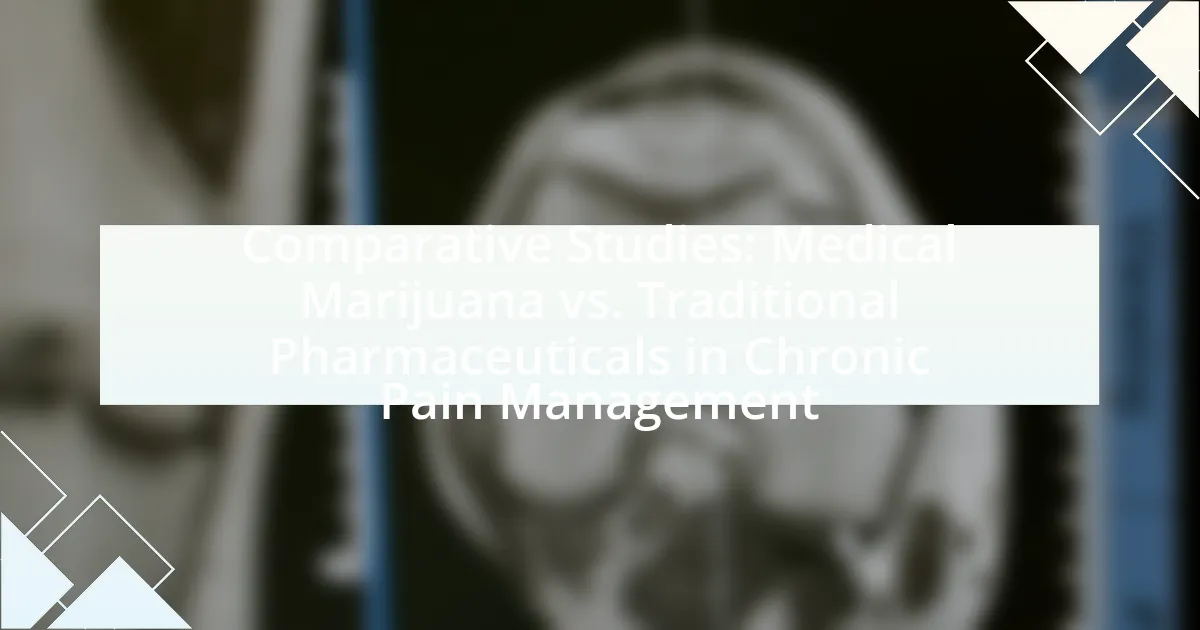The article examines the comparative effectiveness of medical marijuana and traditional pharmaceuticals in managing chronic pain. It highlights key differences in their mechanisms, side effects, and regulatory status, emphasizing how medical marijuana utilizes cannabinoids like THC and CBD to interact with the endocannabinoid system, while traditional pharmaceuticals often rely on opioids and NSAIDs. The article discusses research findings that suggest medical marijuana may provide better pain relief with fewer side effects compared to opioids, alongside an exploration of legal considerations, patient demographics, and future research directions in this evolving field.

What are the key differences between medical marijuana and traditional pharmaceuticals in chronic pain management?
Medical marijuana and traditional pharmaceuticals differ significantly in their mechanisms, side effects, and regulatory status in chronic pain management. Medical marijuana primarily utilizes cannabinoids, such as THC and CBD, which interact with the endocannabinoid system to alleviate pain and inflammation. In contrast, traditional pharmaceuticals often include opioids and non-steroidal anti-inflammatory drugs (NSAIDs), which target pain through different biochemical pathways.
The side effect profiles also vary; medical marijuana may cause psychoactive effects, increased appetite, and potential dependency, while traditional pharmaceuticals, particularly opioids, carry risks of addiction, overdose, and gastrointestinal issues. Furthermore, medical marijuana is subject to varying state regulations and lacks FDA approval for many uses, whereas traditional pharmaceuticals undergo rigorous clinical trials and regulatory scrutiny before approval.
Research indicates that patients may experience better pain relief and fewer side effects with medical marijuana compared to opioids, as shown in a study published in the Journal of Pain Research, which found that 62% of patients reported reduced pain after using medical cannabis. This highlights the distinct approaches and implications of using medical marijuana versus traditional pharmaceuticals in managing chronic pain.
How do medical marijuana and traditional pharmaceuticals interact with the body?
Medical marijuana and traditional pharmaceuticals interact with the body through different mechanisms, primarily involving the endocannabinoid system and various receptor pathways. Medical marijuana contains cannabinoids like THC and CBD, which bind to cannabinoid receptors (CB1 and CB2) in the brain and immune system, influencing pain perception, inflammation, and mood. In contrast, traditional pharmaceuticals often target specific neurotransmitter systems, such as opioids binding to mu-opioid receptors, which can lead to pain relief but also carry risks of addiction and side effects.
Research indicates that cannabinoids can modulate the effects of traditional medications, potentially enhancing analgesic effects or reducing side effects. For example, a study published in the Journal of Pain Research found that combining cannabinoids with opioids may allow for lower opioid dosages while maintaining pain relief, thus minimizing the risk of opioid-related adverse effects. This highlights the complex interplay between medical marijuana and traditional pharmaceuticals in managing chronic pain.
What are the active compounds in medical marijuana that affect pain management?
The active compounds in medical marijuana that affect pain management are primarily cannabinoids, with tetrahydrocannabinol (THC) and cannabidiol (CBD) being the most significant. THC is known for its analgesic properties, which can help alleviate pain by binding to cannabinoid receptors in the brain and nervous system, thereby reducing the perception of pain. CBD, on the other hand, has anti-inflammatory effects and can modulate pain signaling pathways, making it effective in managing chronic pain conditions. Research has shown that these cannabinoids can provide relief for various types of pain, including neuropathic and inflammatory pain, supporting their use in medical settings for pain management.
How do traditional pharmaceuticals target pain pathways in the body?
Traditional pharmaceuticals target pain pathways in the body primarily through the modulation of neurotransmitter activity and the inhibition of inflammatory processes. Nonsteroidal anti-inflammatory drugs (NSAIDs), for example, reduce pain by inhibiting cyclooxygenase enzymes, which decreases the production of prostaglandins that sensitize pain receptors. Opioids, on the other hand, bind to specific receptors in the brain and spinal cord, effectively blocking pain signals and altering the perception of pain. Research indicates that opioids can reduce pain intensity by up to 70% in certain conditions, demonstrating their effectiveness in pain management. Additionally, adjuvant medications like antidepressants and anticonvulsants can enhance pain relief by targeting different pathways, such as serotonin and norepinephrine reuptake inhibition, which further supports their role in comprehensive pain management strategies.
What are the legal and regulatory considerations for using medical marijuana?
The legal and regulatory considerations for using medical marijuana vary significantly by jurisdiction, impacting its accessibility and use. In the United States, for example, medical marijuana is legal in 38 states and the District of Columbia, but it remains classified as a Schedule I substance under federal law, which complicates its regulation and research. States typically require patients to obtain a medical marijuana card through a licensed healthcare provider, and regulations often dictate the amount of marijuana a patient can possess and the forms in which it can be consumed. Additionally, compliance with state-specific laws regarding cultivation, distribution, and sales is essential for both patients and providers. These legal frameworks are designed to ensure safe access while addressing public health concerns, as evidenced by the establishment of state regulatory bodies that oversee medical marijuana programs.
How do state laws vary regarding medical marijuana use for chronic pain?
State laws regarding medical marijuana use for chronic pain vary significantly across the United States. Some states, like California and Colorado, have comprehensive medical marijuana programs that allow patients with chronic pain to obtain cannabis with a physician’s recommendation. In contrast, states such as Idaho and Nebraska have not legalized medical marijuana at all, leaving patients without legal access to cannabis for pain management. Additionally, states like Florida and New York have specific qualifying conditions for medical marijuana, which may include chronic pain but require documentation and approval from licensed healthcare providers. This variation reflects differing state policies, public opinion, and legislative approaches to cannabis use for medical purposes.
What are the implications of federal regulations on medical marijuana research?
Federal regulations significantly restrict medical marijuana research by imposing stringent requirements for obtaining research licenses and access to cannabis products. These regulations limit the number of approved research facilities and the types of studies that can be conducted, which hinders the ability to gather comprehensive data on the efficacy and safety of medical marijuana compared to traditional pharmaceuticals. For instance, the Drug Enforcement Administration (DEA) classifies marijuana as a Schedule I substance, indicating a high potential for abuse and no accepted medical use, which complicates the research process and funding opportunities. Consequently, the lack of robust clinical trials and peer-reviewed studies due to these regulatory barriers results in insufficient evidence to inform medical professionals and patients about the potential benefits and risks of medical marijuana in chronic pain management.
What are the potential side effects of medical marijuana compared to traditional pharmaceuticals?
Medical marijuana can cause side effects such as dizziness, dry mouth, increased heart rate, and impaired cognitive function, while traditional pharmaceuticals often lead to side effects like gastrointestinal issues, dependency, and organ damage. Research indicates that the side effects of medical marijuana are generally considered to be less severe and more manageable compared to those associated with opioids and other conventional pain medications. For instance, a study published in the Journal of Pain Research found that patients using medical cannabis reported fewer adverse effects than those using opioids, highlighting the potential for a safer profile in chronic pain management.
What common side effects are associated with medical marijuana use?
Common side effects associated with medical marijuana use include dry mouth, dizziness, fatigue, and increased appetite. Research indicates that these effects are frequently reported among users, with dry mouth occurring in approximately 30% of patients, as noted in a study published in the Journal of Pain and Symptom Management. Additionally, dizziness and fatigue are commonly experienced, particularly in new users or those consuming higher doses. Increased appetite, often referred to as “the munchies,” is another well-documented effect, which can be beneficial for patients undergoing treatments that cause appetite loss.
How do the side effects of traditional pharmaceuticals differ from those of medical marijuana?
The side effects of traditional pharmaceuticals often include gastrointestinal issues, dizziness, and dependency, while medical marijuana typically presents side effects such as dry mouth, altered mental state, and fatigue. Traditional pharmaceuticals, particularly opioids, can lead to addiction and withdrawal symptoms, which are less common with medical marijuana use. Research indicates that opioids are associated with a higher risk of overdose and long-term dependency, whereas medical marijuana has a lower potential for abuse, as evidenced by a study published in the Journal of Pain Research, which found that patients using medical marijuana reported fewer severe side effects compared to those on opioid therapy.

What evidence exists from comparative studies on medical marijuana and traditional pharmaceuticals?
Comparative studies indicate that medical marijuana can be as effective as traditional pharmaceuticals for chronic pain management. For instance, a systematic review published in the Journal of Pain in 2018 analyzed 27 studies and found that cannabinoids significantly reduced pain in patients with chronic pain conditions, often with fewer side effects compared to opioids. Additionally, a study in the Journal of the American Medical Association (JAMA) in 2015 reported that patients using medical marijuana experienced a 64% reduction in opioid use, suggesting that marijuana may serve as a viable alternative or adjunct to traditional pain medications. These findings highlight the potential of medical marijuana in managing chronic pain effectively while mitigating the risks associated with conventional pharmaceuticals.
How effective is medical marijuana in managing chronic pain compared to traditional pharmaceuticals?
Medical marijuana is effective in managing chronic pain, often providing comparable or superior relief to traditional pharmaceuticals. Studies indicate that cannabinoids can reduce pain intensity and improve quality of life for patients with conditions such as neuropathic pain and arthritis. For instance, a systematic review published in the Journal of Pain in 2018 found that medical cannabis significantly reduced pain in chronic pain patients, with many reporting a decrease in opioid use. Additionally, a study in the Journal of the American Medical Association (JAMA) in 2015 demonstrated that patients using medical marijuana experienced a 64% reduction in opioid use, highlighting its potential as an alternative or adjunct to traditional pain medications.
What do clinical trials reveal about the efficacy of medical marijuana for chronic pain?
Clinical trials indicate that medical marijuana is effective in reducing chronic pain. A systematic review published in the Journal of Pain in 2018 analyzed data from multiple studies and found that cannabinoids significantly reduced pain levels in patients with chronic pain conditions, including neuropathic pain and cancer-related pain. Additionally, a meta-analysis in the Cochrane Database of Systematic Reviews in 2020 concluded that cannabinoids provide moderate pain relief compared to placebo, supporting the use of medical marijuana as a viable option for chronic pain management.
How do patient-reported outcomes compare between medical marijuana and traditional pharmaceuticals?
Patient-reported outcomes indicate that medical marijuana often results in higher satisfaction and perceived effectiveness compared to traditional pharmaceuticals for chronic pain management. Studies have shown that patients using medical marijuana report greater reductions in pain levels and improved quality of life. For instance, a systematic review published in the Journal of Pain found that 62% of patients using cannabis reported significant pain relief, while only 30% of those using opioids reported similar outcomes. Additionally, patients using medical marijuana frequently experience fewer side effects, leading to better adherence to treatment. This evidence suggests that medical marijuana may provide a more favorable patient experience than traditional pharmaceuticals in managing chronic pain.
What are the cost implications of using medical marijuana versus traditional pharmaceuticals?
The cost implications of using medical marijuana versus traditional pharmaceuticals can vary significantly, often making medical marijuana a more affordable option for patients. A study published in the Journal of Pain Research found that patients using medical marijuana reported a 64% reduction in prescription medication costs, as they were able to decrease or eliminate their use of opioids and other pharmaceuticals. Additionally, the average monthly cost of medical marijuana can range from $100 to $300, while traditional pharmaceuticals for chronic pain management can exceed $1,000 monthly, depending on the specific medications and dosages required. This cost difference highlights the potential financial benefits of medical marijuana as an alternative treatment for chronic pain.
How do the costs of medical marijuana compare to those of traditional pain medications?
The costs of medical marijuana are generally higher than those of traditional pain medications. For example, a study published in the Journal of Pain Research indicated that patients using medical marijuana spent an average of $200 to $300 per month, while traditional opioids and non-opioid pain medications typically cost between $50 to $150 per month. Additionally, the price of medical marijuana can vary significantly based on state regulations, product type, and dispensary pricing, whereas traditional medications often have more standardized pricing due to insurance coverage and generic options.
What factors influence the overall cost-effectiveness of medical marijuana in chronic pain management?
The overall cost-effectiveness of medical marijuana in chronic pain management is influenced by factors such as the price of the product, dosage requirements, patient adherence, and the comparative effectiveness against traditional pharmaceuticals. The price of medical marijuana varies significantly based on quality, strain, and local regulations, impacting overall treatment costs. Dosage requirements can differ, as some patients may need higher doses of marijuana compared to conventional medications, affecting long-term expenses. Patient adherence is crucial; studies indicate that patients may prefer medical marijuana due to fewer side effects, which can lead to better compliance and potentially lower overall costs. Additionally, comparative effectiveness research shows that medical marijuana may provide similar or superior pain relief compared to opioids and non-steroidal anti-inflammatory drugs, which can lead to reduced healthcare costs associated with managing side effects or complications from traditional pharmaceuticals.
What are the patient demographics and preferences regarding medical marijuana and traditional pharmaceuticals?
Patient demographics regarding medical marijuana and traditional pharmaceuticals show that younger adults, particularly those aged 18 to 34, are more likely to prefer medical marijuana, while older adults tend to favor traditional pharmaceuticals. A study published in the Journal of Pain Research indicated that 62% of patients aged 18-34 reported using medical marijuana for chronic pain management, compared to only 25% of patients aged 65 and older who expressed a preference for it. Additionally, preferences are influenced by factors such as previous experiences with pharmaceuticals, perceived effectiveness, and concerns about side effects. Research from the National Institute on Drug Abuse highlights that patients often seek alternatives to opioids due to the risk of addiction and adverse effects associated with traditional medications.
How do age and gender influence the choice between medical marijuana and traditional pharmaceuticals?
Age and gender significantly influence the choice between medical marijuana and traditional pharmaceuticals, with younger individuals and males showing a higher preference for medical marijuana. Research indicates that younger adults, particularly those aged 18-34, are more likely to use cannabis for pain management compared to older adults, who tend to favor traditional pharmaceuticals due to established medical practices and concerns about cannabis legality and safety. Additionally, studies reveal that men are more inclined to choose medical marijuana over women, who often express greater apprehension regarding its use and may prefer conventional medications due to perceived reliability and physician recommendations. This trend is supported by data from the National Institute on Drug Abuse, which highlights demographic differences in substance use patterns, emphasizing the role of age and gender in treatment preferences.
What are the common reasons patients prefer medical marijuana over traditional pharmaceuticals?
Patients commonly prefer medical marijuana over traditional pharmaceuticals due to its perceived effectiveness, fewer side effects, and lower risk of addiction. Research indicates that many patients find medical marijuana provides better pain relief for chronic conditions compared to opioids and other pharmaceuticals, which often come with significant side effects such as nausea, constipation, and sedation. Additionally, a study published in the Journal of Pain Research found that patients using medical marijuana reported a 64% reduction in chronic pain, highlighting its efficacy. Furthermore, the risk of developing a dependency on medical marijuana is significantly lower than that associated with opioids, making it a safer alternative for long-term management of chronic pain.

What are the future directions for research in medical marijuana and traditional pharmaceuticals?
Future research directions in medical marijuana and traditional pharmaceuticals focus on understanding the efficacy, safety, and mechanisms of action of cannabinoids compared to conventional medications. Studies are increasingly examining the pharmacokinetics and pharmacodynamics of cannabinoids, aiming to establish standardized dosing guidelines and identify specific patient populations that may benefit most from medical marijuana. Additionally, research is exploring the potential for synergistic effects when combining cannabinoids with traditional pharmaceuticals, which could enhance pain management outcomes. Clinical trials are also being conducted to assess long-term effects and the impact of medical marijuana on quality of life in chronic pain patients, providing a more comprehensive understanding of its role alongside traditional therapies.
How can future studies improve our understanding of medical marijuana’s role in chronic pain management?
Future studies can improve our understanding of medical marijuana’s role in chronic pain management by conducting rigorous clinical trials that compare its efficacy and safety against traditional pharmaceuticals. These studies should focus on specific patient populations, dosage variations, and long-term effects, which are often overlooked in current research. For instance, a systematic review published in the Journal of Pain Research in 2020 found that cannabinoids can reduce chronic pain, but the variability in study designs limits the ability to draw definitive conclusions. By standardizing methodologies and including diverse demographics, future research can provide clearer insights into how medical marijuana can be effectively integrated into chronic pain management protocols.
What gaps exist in current research that need to be addressed?
Current research on the comparative effectiveness of medical marijuana versus traditional pharmaceuticals in chronic pain management lacks comprehensive longitudinal studies that assess long-term outcomes and side effects. Existing studies often focus on short-term efficacy, neglecting the potential for adverse effects over extended use, which is critical for informed clinical decision-making. Additionally, there is insufficient data on the optimal dosing and delivery methods of medical marijuana compared to established pharmaceuticals, which limits the ability to create standardized treatment protocols. Furthermore, demographic variations in response to treatment, such as age, gender, and pre-existing conditions, are underexplored, leading to a gap in personalized medicine approaches in chronic pain management.
How can interdisciplinary approaches enhance the study of medical marijuana and traditional pharmaceuticals?
Interdisciplinary approaches can enhance the study of medical marijuana and traditional pharmaceuticals by integrating diverse fields such as pharmacology, medicine, psychology, and sociology. This integration allows for a comprehensive understanding of the efficacy, safety, and societal implications of both treatment modalities. For instance, pharmacological research can provide insights into the biochemical interactions of cannabinoids, while psychological studies can assess patient-reported outcomes and quality of life improvements. Furthermore, sociological perspectives can explore the cultural attitudes and legal frameworks surrounding medical marijuana use, which can influence patient access and acceptance. By combining these disciplines, researchers can develop more holistic treatment protocols that consider not only the biological effects but also the psychological and social dimensions of pain management.
What best practices should patients consider when choosing between medical marijuana and traditional pharmaceuticals for chronic pain?
Patients should consider several best practices when choosing between medical marijuana and traditional pharmaceuticals for chronic pain. First, patients should consult with healthcare professionals to evaluate their specific medical history and pain management needs, as personalized advice can significantly influence treatment effectiveness. Second, patients should review the legal status and regulations surrounding medical marijuana in their region, as this can affect accessibility and quality. Third, patients should assess the potential side effects and interactions of both options; for instance, traditional pharmaceuticals may have well-documented side effects, while medical marijuana’s effects can vary widely based on strain and dosage. Lastly, patients should consider starting with lower doses of medical marijuana and gradually increasing as needed, while monitoring their pain levels and any side effects, to find the most effective and tolerable treatment. These practices are supported by research indicating that individualized approaches to pain management yield better outcomes.
How can patients effectively communicate with healthcare providers about their pain management options?
Patients can effectively communicate with healthcare providers about their pain management options by being clear and specific about their pain experiences and treatment preferences. This includes describing the intensity, location, and nature of their pain, as well as discussing any previous treatments and their outcomes. Research indicates that patients who actively engage in their healthcare discussions are more likely to receive tailored pain management strategies that align with their needs. For instance, a study published in the Journal of Pain Research found that effective communication between patients and providers leads to improved pain relief and satisfaction with care.
What resources are available for patients seeking information on medical marijuana and traditional pharmaceuticals?
Patients seeking information on medical marijuana and traditional pharmaceuticals can access various resources, including government health websites, medical journals, and patient advocacy organizations. The National Institute on Drug Abuse provides research and data on marijuana’s effects and uses, while the National Institutes of Health offers comprehensive information on pharmaceuticals. Additionally, peer-reviewed journals such as the Journal of Pain Research publish comparative studies on the efficacy of medical marijuana versus traditional medications in chronic pain management, providing evidence-based insights. Patient advocacy groups like the American Medical Association also offer guidance and resources for understanding treatment options.

Leave a Reply